RE3+-Doped Ca3(Nb,Ga)5O12 and Ca3(Li,Nb,Ga)5O12 Crystals (RE = Sm, Dy, and Pr): A Review of Current Achievements
Abstract
:1. Introduction
2. Materials and Methods
3. Results
3.1. Crystals Growth and Structural Characterization
3.2. Spectroscopic Investigations
- Sm3+ ions
- Dy3+ ions
- Pr3+ ions
4. Conclusions
Author Contributions
Funding
Institutional Review Board Statement
Informed Consent Statement
Data Availability Statement
Conflicts of Interest
References
- Ramírez, M.; Romero, J.; Molina, P.; Bausá, L.E. Near infrared and visible tunability from a diode pumped Nd3+ activated strontium barium niobate laser crystal. Appl. Phys. B 2005, 81, 827–830. [Google Scholar] [CrossRef]
- Bettinelli, M.; Speghini, A.; Ródenas, A.; Molina, P.; Ramírez, M.; Capote, B.; Jaque, D.; Bausá, L.E.; García Solé, J. Luminescence of lanthanide ions in strontium barium niobate. J. Lumin. 2007, 122–123, 307–310. [Google Scholar] [CrossRef]
- Xie, G.Q.; Tang, D.Y.; Tan, W.D.; Luo, H.; Zhang, H.J.; Yu, H.H.; Wang, J.Y. Subpicosecond pulse generation from a Nd:CLNGG disordered crystal laser. Opt. Lett. 2009, 34, 103–105. [Google Scholar] [CrossRef] [PubMed]
- Gheorghe, C.; Gheorghe, L.; Loiseau, P.; Aka, G. Spectroscopic features, and laser performance at 1.06 µm of Nd3+ doped Gd1−xLuxCa4O(BO3)3 single crystal. J. Appl. Phys. 2012, 111, 13102. [Google Scholar] [CrossRef]
- Marzahl, D.T.; Reichert, F.; Metz, P.W.; Fechner, M.; Hansen, N.O.; Huber, G. Efficient laser operation of diode-pumped Pr3+,Mg2+:SrAl12O19. Appl. Phys. B 2014, 116, 109–113. [Google Scholar] [CrossRef]
- Sani, E.; Brugioni, A.; Mercatelli, L.; Parisi, D.; Zharikov, E.V.; Lis, D.A.; Subbotin, K.A. Yb-doped double tungstates for down-conversion applications. Opt. Mater. 2019, 94, 415–422. [Google Scholar] [CrossRef]
- Broasca, A.; Greculeasa, M.; Voicu, F.; Hau, S.; Croitoru, G.; Gheorghe, C.; Pavel, N.; Gheorghe, L. Efficient near-infrared laser emission and nonlinear optical properties of a newly developed Yb:LYSB laser crystal. J. Alloy. Compd. 2020, 844, 156143. [Google Scholar] [CrossRef]
- Kaminskii, A.A.; Belokoneva, E.L.; Butashin, A.V.; Markosian, A.A.; Mill, B.V.; Nikolskaia, O.; Sarkisov, S.E. Crystal structure and spectral luminescence properties of the cation-deficient garnet Ca3(Nb, Ga)2Ga3O12-Nd3+. Inorg. Mater. 1986, 22, 927–936. [Google Scholar]
- Voron’ko, Y.K.; Kudryavtsev, A.B.; Es’kov, N.A.; Osiko, V.V.; Sobol’, A.A.; Sorokin, E.V.; Spiridonov, F.M. Raman scattering of light in crystals and melt of calcium-niobium gallium garnet. Sov. Phys. Dokl. 1988, 32, 70–73. [Google Scholar]
- Shi, Z.B.; Zhang, H.J.; Wang, J.Y.; Yu, Y.G.; Wang, Z.P.; Yu, H.H.; Sun, S.Q.; Xia, H.R.; Jiang, M.H. Growth and characterization of Nd:CLNGG crystal. J. Cryst Growth 2009, 311, 3792. [Google Scholar] [CrossRef]
- Voronko, Y.K.; Gessen, S.B.; Es’Kov, N.A.; Sobol, A.A.; Ushakov, S.N.; Tsymbal, L.I. Efficient active media based on Nd3+-activated calcium niobium gallium garnets. Sov. J. Quantum Electron. 1990, 20, 246. [Google Scholar] [CrossRef]
- Yu, Y.M.; Chani, V.I.; Shimamura, K.; Fukuda, T. Growth of Ca3(Li,Nb,Ga)5O12 garnet crystals from stoichiometric melts. J. Cryst. Growth 1997, 171, 463. [Google Scholar] [CrossRef]
- Brenier, A.; Boulon, G.; Shimamura, K.; Fukuda, T. Growth by the μ-pulling-down method and spectroscopic investigation of Nd3+-doped calcium niobium gallium garnet. J. Cryst. Growth 1999, 204, 145. [Google Scholar] [CrossRef]
- Agnesi, A.; Dell’Acqua, S.; Guandalini, A.; Reali, G.; Cornacchia, F.; Toncelli, A.; Toncelli, M.; Shimamura, K.; Fukuda, T. Optical spectroscopy and diode-pumped laser performance of Nd3+ in the CNGG crystal. IEEE J. Quant. Electron. 2001, 37, 304–313. [Google Scholar] [CrossRef]
- Lupei, A.; Lupei, V.; Gheorghe, L.; Rogobete, L.; Petraru, A. The nature of nonequivalent Nd3+centers in CNGG and CLNGG. Opt. Mater. 2001, 16, 403–411. [Google Scholar] [CrossRef]
- Voron’Ko, Y.K.; Sobol’, A.A.; Ushakov, S.N.; Shukshin, V.E. Spectroscopy of Disordered Laser Crystals. Inorg. Mater. 2002, 38, 390–396. [Google Scholar] [CrossRef]
- Voronko, Y.; Sobol, A.; Karasik, A.; Eskov, N.; Rabochkina, P.; Ushakov, S. Calcium niobium gallium and calcium lithium niobium gallium garnets doped with rare earth ions–effective laser media. Opt. Mater. 2002, 20, 197–209. [Google Scholar] [CrossRef]
- Gao, W.L.; Xie, G.Q.; Ma, J.; Liu, M.N.; Yuan, P.; Qian, L.J.; Yu, H.H.; Zhang, H.J.; Wang, J.Y.; Zhang, J. Spectroscopic characteristics and efficient laser operation of Tm: CLNGG disordered crystal. Laser Phys. Lett. 2013, 10, 055809. [Google Scholar] [CrossRef]
- Toma, O.; Georgescu, S. Judd-Ofelt analysis of Er3+ions in calcium lithium niobium gallium garnet. J. Lumin. 2014, 147, 259–264. [Google Scholar] [CrossRef]
- Xiao, K.; Lin, B.; Zhang, Q.-L.; Zhang, D.-X.; Feng, B.-H.; He, J.-L.; Zhang, H.-J.; Wang, J.-Y. Q-switched 1329 nm Nd: CNGG laser. Appl. Opt. 2001, 54, 7071–7075. [Google Scholar] [CrossRef]
- Gheorghe, C.; Hau, S.; Gheorghe, L.; Voicu, F.; Greculeasa, M.; Achim, A.; Enculescu, M. Optical properties of Sm3+ doped Ca3(Nb,Ga)5O12 and Ca3(Li,Nb,Ga)5O12 single crystals. J. Lumin. 2017, 186, 175–182. [Google Scholar] [CrossRef]
- Ryabochkina, P.A.; Chabushkin, A.N.; Zakharov, N.G.; Vorontsov, K.V.; Khrushchalina, S.A. Tunable 2-μm lasing in calcium—niobium—gallium garnet crystals doped with Ho3+ ions. Quantum Electron. 2017, 47, 607–609. [Google Scholar] [CrossRef]
- Gheorghe, C.; Hau, S.; Gheorghe, L.; Voicu, F.; Greculeasa, M.; Enculescu, M.; Belikov, K.N.; Bryleva, Y.E.; Gaiduk, O.V. Yellow laser potential of cubic Ca3(Nb,Ga)5O12:Dy3+ and Ca3(Li,Nb,Ga)5O12:Dy3+ single crystals. J. Alloys Compd. 2018, 739, 806–816. [Google Scholar] [CrossRef]
- Hau, S.; Gheorghe, C.; Gheorghe, L.; Voicu, F.; Greculeasa, M.; Stanciu, G.; Broasca, A.; Enculescu, M. Spectroscopic investigations of Pr3+ ions doped CNGG and CLNGG single crystals. J. Alloys Compd. 2019, 799, 288–301. [Google Scholar] [CrossRef]
- Hau, S.; Stanciu, G.; Avram, D.; Gheorghe, L.; Gheorghe, C. Energy transfer and luminescent properties of Tb3+ and Tb3+, Yb3+ doped CNGG phosphors. J. Rare Earths 2022, 40, 1445–1453. [Google Scholar] [CrossRef]
- Yu, H.; Zhang, H.; Wang, Z.; Wang, J.; Yu, Y.; Shi, Z.; Zhang, X.; Jiang, M. High-power dual-wavelength laser with disordered Nd:CNGG crystals. Opt. Lett. 2009, 34, 151–153. [Google Scholar] [CrossRef]
- Yu, H.; Zhang, H.; Wang, Z.; Wang, J.; Yu, Y.; Shi, Z.; Zhang, X.; Jiang, M. Continuous-wave and passively Q-switched laser performance with a disordered Nd:CLNGG crystal. Opt. Express 2009, 17, 19015–19020. [Google Scholar] [CrossRef]
- Li, Y.L.; Jiang, H.L.; Ni, T.Y.; Zhang, T.Y.; Tao, Z.H.; Zeng, Y.H. Efficient 1061 and 1329 nm laser emission of Nd:CNGG lasers under 885 nm diode pumping into the emitting level. Laser Phys. 2011, 21, 485–488. [Google Scholar] [CrossRef]
- Liu, C.-X.; Shen, X.-L.; Li, W.-N.; Wei, W. Visible and near-infrared optical properties of Nd: CLNGG crystal waveguides formed by proton implantation. Chin. Phys. B 2017, 26, 034207. [Google Scholar] [CrossRef]
- Schmidt, A.; Griebner, U.; Zhang, H.; Wang, J.; Jiang, M.; Liu, J.; Petrov, V. Passive mode-locking of the Yb:CNGG laser. Opt. Commun. 2010, 283, 567. [Google Scholar] [CrossRef]
- Ma, J.; Pan, Z.; Wang, J.; Yuan, H.; Cai, H.; Xie, G.; Qian, L.; Shen, D.; Tang, D. Generation of sub-50fs soliton pulses from a mode-locked Yb,Na: CNGG disordered crystal laser. Opt Express 2017, 25, 14968–14973. [Google Scholar] [CrossRef] [PubMed]
- Si, W.; Ma, Y.-J.; Wang, L.-S.; Yuan, H.-L.; Kong, W.-J.; Liu, J.-H. Acousto-Optically Q-Switched Operation of Yb: CNGG Disordered Crystal Laser. Chin. Phys. Lett 2017, 34, 124201. [Google Scholar] [CrossRef]
- Merkle, L.D.; Zandi, B. Spectroscopy and laser operation of Pr, Mg:SrAl12O19. J. Appl. Phys. 1996, 79, 1849. [Google Scholar] [CrossRef]
- Fibrich, M.; Jelínková, H.; Šulc, J.; Nejezchleb, K.; Škoda, V. Visible cw laser emission of GaN-diode pumped Pr:YAlO3 crystal. Appl. Phys. B 2009, 97, 363. [Google Scholar] [CrossRef]
- Reichert, F.; Moglia, F.; Marzahl, D.-T.; Metz, P.; Fechner, M.; Hansen, N.-O.; Huber, G. Diode pumped laser operation and spectroscopy of Pr3+:LaF3. Opt. Express 2012, 20, 20387–20395. [Google Scholar] [CrossRef]
- Luo, S.; Cai, Z.; Xu, H.; Shen, Z.; Chen, H.; Li, L.; Cao, Y. Direct oscillation at 640-nm in single longitudinal mode with a diode-pumped Pr:YLF solid-state laser. Opt. Laser Techn. 2019, 116, 112–116. [Google Scholar] [CrossRef]
- Damiano, E.; Cittadino, G.; Di Lieto, A.; Tonelli, M. Deep Red Tunability and Output Power Performances of Visible Laser Emission in a Pr:Ba(Y1−xLux)2F8 Single Crystal. Materials 2020, 13, 4655. [Google Scholar] [CrossRef]
- Wang, G.Q.; Lin, Y.F.; Gong, X.H.; Chen, Y.J.; Huang, J.H.; Luo, Z.D.; Huang, Y.D. Polarized spectral properties of Sm3+:LiYF4 crystal. J. Lumin. 2014, 147, 23–26. [Google Scholar] [CrossRef]
- Demesh, M.P.; Dernovich, O.P.; Gusakova, N.V.; Yasukevich, A.S.; Kornienko, A.A.; Dunina, E.B.; Fomicheva, L.A.; Pavlyuk, A.A.; Kuleshov, N.V. Growth and spectroscopic properties of Sm3+:KY(WO4)2 crystal. Opt. Mater. 2018, 75, 821–826. [Google Scholar] [CrossRef]
- Huang, J.; Huang, J.; Lin, Y.; Gong, X.; Chen, Y.; Luo, Z.; Huang, Y. Spectroscopic properties of Sm3+-doped NaGd(MoO4)2 crystal for visible laser application. J. Lumin. 2017, 187, 235–239. [Google Scholar] [CrossRef]
- Zhu, K.; Zhou, H.; Qiu, J.; Wang, L.G.; Ye, L. Optical temperature sensing characteristics of Sm3+ doped YAG single crystal fiber based on luminescence emission. J. Alloys Compd. 2022, 890, 161844. [Google Scholar] [CrossRef]
- Fujimoto, Y.; Ishii, O.; Yamazaki, M. 575 nm laser oscillation in Dy3+-doped waterproof fluoro-aluminate glass fiber pumped by violet GaN laser diodes. In Solid State Lasers XX: Technology and Devices; SPIE: Washington, DC, USA, 2011; Volume 7912. [Google Scholar] [CrossRef]
- Haro-González, P.; Martín, L.L.; Martín, I.R.; Dominiak-Dzik, G.; Ryba-Romanowski, W. Pump and probe measurements of optical amplification at 584nm in dysprosium doped lithium niobate crystal. Opt. Mater. 2010, 33, 196–199. [Google Scholar] [CrossRef]
- Ganesh Kumar, K.; Balaji Bhargav, P.; Aravinth, K.; Arumugam, R.; Ramasamy, P. Dysprosium activated strontium aluminate phosphor: A potential candidate for WLED applications. J. Lumin. 2020, 223, 117126. [Google Scholar] [CrossRef]
- Tang, W.; Guo, Q.; Su, K.; Liu, H.; Zhang, Y.; Mei, L.; Liao, L. Structure and Photoluminescence Properties of Dy3+ Doped Phosphor with Whitlockite Structure. Materials 2022, 15, 2177. [Google Scholar] [CrossRef]
- Boruc, Z.; Kaczkan, M.; Fetlinski, B.; Turczynski, S.; Malinowski, M. Blue emissions in Dy3+ doped Y4Al2O9 crystals for temperature sensing. Opt. Lett. 2012, 37, 5214–5216. [Google Scholar] [CrossRef]
- Gheorghe, L.; Greculeasa, M.; Voicu, F.; Gheorghe, C.; Hau, S.; Vlaicu, A.M.; Belikov, K.N.; Bryleva, Y.E.; Gaiduk, O.V. Crystal growth and structural characterization of Sm3+, Pr3+ and Dy3+-doped CNGG and CLNGG single crystals. Opt. Mater. 2018, 84, 335–338. [Google Scholar] [CrossRef]
- Judd, B.R. Optical Absorption Intensities of Rare-Earth Ions. Phys. Rev. 1962, 127, 750–761. [Google Scholar] [CrossRef]
- Ofelt, G.S. Intensities of Crystal Spectra of Rare-Earth Ions. J. Chem. Phys. 1962, 37, 511–520. [Google Scholar] [CrossRef]
- Zhang, H.; Liu, J.H.; Wang, J.Y.; Fan, J.D.; Tao, X.T.; Mateos, X.; Petrov, V.; Jiang, M.H. Spectroscopic properties and continuous-wave laser operation of a new disordered crystal: Yb-doped CNGG. Opt. Express 2007, 15, 9464. [Google Scholar] [CrossRef]
- Basiev, T.T.; Es’kov, N.A.; Karasik, A.Y.; Osiko, V.V.; Sobol, A.A.; Ushakov, S.N.; Helbig, M. Disordered garnets Ca3(Nb, Ga)5O12:Nd3+-prospective crystals for powerful ultrashort-pulse generation. Opt. Lett. 1992, 17, 201. [Google Scholar] [CrossRef]
- Carnall, W.T.; Fields, P.R.; Rajnak, K. Electronic Energy Levels in the Trivalent Lanthanide Aquo Ions. I. Pr3+, Nd3+, Pm3+, Sm3+, Dy3+, Ho3+, Er3+, and Tm3+. J. Chem. Phys. 1968, 49, 4424–4442. [Google Scholar] [CrossRef]
- Krupke, W.F. Induced-emission cross sections in neodymium laser glasses. IEEE J. Quant. Electron. 1974, 10, 450–457. [Google Scholar] [CrossRef]
- Förster, T. Experimental and theoretical investigation of intermolecular transfer of electronic excitation energy. Z. Naturforsch. 1949, 4a, 321. [Google Scholar] [CrossRef]
- Dexter, D.L. Theory of the optical properties of imperfections in nonmetals. Solid State Phys. 1958, 6, 355. [Google Scholar] [CrossRef]
- Inokuti, M.; Hirayama, F. Influence of energy transfer by the exchange mechanism on donor luminescence. J. Chem. Phys. 1965, 43, 1978–1989. [Google Scholar] [CrossRef]
- Malinowski, M.; Wolski, R.; Frukacz, Z.; Lukasiewicz, T.; Luczyrlski, Z. Spectroscopic studies of YAG:Sm3+ crystals. J Appl Spectrosc 1995, 62, 840–843. [Google Scholar] [CrossRef]
- Di, J.; Xu, X.; Xia, C.; Zeng, H.; Cheng, Y.; Li, D.; Zhou, D.; Wu, F.; Cheng, J.; Xu, J. Crystal growth and optical properties of Sm:CaNb2O6 single crystal. J. Alloys Compd. 2012, 536, 20. [Google Scholar] [CrossRef]
- Dominiak-Dzik, G.; Ryba-Romanowski, W.; Lisiecki, R.; Solarz, P.; Berkowski, M. Dy-doped Lu2SiO5 single crystal: Spectroscopic characteristics and luminescence dynamics. Appl. Phys. B 2010, 99, 285–297. [Google Scholar] [CrossRef]
- Wang, Y.; Wang, B.; Wu, D.; Lin, S.; Zhou, Z.; Zhu, Y. Optical properties of Sm3+ doped Mg:LiNbO3 and Zn:LiNbO3 single crystals. Opt. Mater. 2012, 34, 845. [Google Scholar] [CrossRef]
- Krupke, W.F. Optical Absorption and Fluorescence Intensities in Several Rare-Earth-Doped Single Crystals. Phys. Rev. 1966, 145, 325. [Google Scholar] [CrossRef]
- Ravi Kanthumar, V.V.; Bhatnnagar, A.K. Effect of modifier ions on the covalency of Nd3+ ions in cadmium borate glasses. Opt. Mater. 1998, 11, 41. [Google Scholar] [CrossRef]
- Voronko, Y.K.; Popov, A.V.; Sobol, A.A.; Ushakov, S.N. Yb3+ ion in calcium niobium gallium garnet crystals: Nearest neighbor environment and optical spectra. Inorg. Mater. 2006, 42, 1133–1137. [Google Scholar] [CrossRef]
- He, X.; Zhang, L.; Chen, G.; Hang, Y. Crystal growth and spectral properties of Sm:GdVO4. J. Alloys Compd. 2012, 536, 366. [Google Scholar] [CrossRef]
- Malinowski, M.; Kaczkan, M.; Turczynski, S. Energy transfer and upconversion of Sm3+ ions in YAlO3. Opt. Mater. 2017, 63, 128–133. [Google Scholar] [CrossRef]
- Solarz, P.; Sobczyk, M. Spectroscopic properties of Sm3+ in KZnLa(PO4)2 in IR–VUV region. Opt. Mater. 2012, 34, 1826. [Google Scholar] [CrossRef]
- Strzep, A.; Lisiecki, R.; Solarz, P.; Ryba-Romanowski, W.; Berkowski, M. Spectroscopic characterization of Sm3+ doped (Lu0.4Gd0.6)2SiO5 single crystals. Opt. Mater. 2014, 36, 740. [Google Scholar] [CrossRef]
- Nagli, L.; Bunimovich, D.; Katzir, A.; Gorodetsky, O.; Molev, V. The luminescence properties of Dy-doped high silicate glass. J. Non-Cryst. Solids 1997, 217, 208–214. [Google Scholar] [CrossRef]
- Bowman, S.R.; O’Connor, S.; Condon, N.J. Diode pumped yellow dysprosium lasers. Opt. Express 2012, 20, 12906–12911. [Google Scholar] [CrossRef]
- Lisiecki, R.; Dominiak-Dzik, G.; Solarz, P.; Ryba-Romanowski, W.; Berkowski, M.; Głowacki, M. Optical spectra and luminescence dynamics of the Dy-doped Gd2SiO5 single crystal. Appl. Phys. B 2010, 98, 337–346. [Google Scholar] [CrossRef]
- Ning, K.; He, X.; Zhang, L.; Liu, Y.; Yin, J.; Zhang, P.; Chen, G.; Wang, X.; Chen, Z.; Shi, C.; et al. Spectroscopic characteristics of GdVO4: Dy3+ crystal. Opt. Mater. 2014, 37, 745–749. [Google Scholar] [CrossRef]
- Wang, Y.; You, Z.; Li, J.; Zhu, Z.; Tu, C. Optical properties of Dy3+ ion in GGG laser crystal. J. Phys. D Appl. Phys. 2010, 43, 075402. [Google Scholar] [CrossRef]
- Lupei, A.; Lupei, V.; Gheorghe, C.; Ikesue, A.; Enculescu, M. Spectroscopic characteristics of Dy3+ doped Y3Al5O12 transparent ceramics. J. Appl. Phys. 2011, 110, 083120. [Google Scholar] [CrossRef]
- Kornienko, A.A.; Kaminskii, A.A.; Dunina, E.B. Dependence of the Line Strength of f-f Transitions on the Manifold Energy, Phys. Stat. Sol. 1990, 157, 261–266. [Google Scholar] [CrossRef]
- Geng, J.; Chen, Y.; Gu, G.; Tian, L. Tunable white-light-emitting Sr2-xCaxNb2O7:Pr3+ phosphor by adjusting the concentration of Ca2+ ion. Opt. Mater. 2014, 36, 1093–1096. [Google Scholar] [CrossRef]
- Noto, L.; Yagoub, M.; Ntwaeaborwa, O.; Swart, H. Persistent photoluminescence emission from SrTa2O6:Pr3+ phosphor prepared at different temperatures. Ceram. Int. 2015, 41, 8828–8836. [Google Scholar] [CrossRef]
- Liu, C.; Pan, F.; Peng, Q.; Zhou, W.; Shi, R.; Zhou, L.; Zhang, J.; Chen, J.; Liang, H. Excitation wavelength dependent luminescence of LuNbO4:Pr3+-influences of intervalence charge transfer and host sensitization. J. Phys. Chem. C 2016, 120, 26044–26053. [Google Scholar] [CrossRef]
- Lei, R.; Luo, X.; Yuan, Z.; Wang, H.; Huang, F.; Deng, D.; Xu, S. Ultrahigh-sensitive optical temperature sensing in Pr3+:Y2Ti2O7 based on diverse thermal response from trap emission and Pr3+ red luminescence. J. Lumin. 2019, 205, 440–445. [Google Scholar] [CrossRef]
- Boutinaud, P.; Cavalli, E.; Bettinelli, M. Emission quenching induced by intervalence charge transfer in Pr3+- or Tb3+-doped YNbO4 and CaNb2O6. J. Phys. Condens. Matter. 2007, 19, 386230. [Google Scholar] [CrossRef]
- Boutinaud, P.; Pinel, E.; Oubaha, M.; Mahiou, R.; Cavalli, E.; Bettinelli, M. Making red emitting phosphors with Pr3+. Opt. Mater. 2006, 28, 9–13. [Google Scholar] [CrossRef]
- Pinelli, S.; Bigotta, S.; Toncelli, A.; Tonelli, M.; Cavalli, E.; Bovero, E. Study of the visible spectra of Ca3Sc2Ge3O12 garnet crystals doped with Ce3+ or Pr3+. Opt. Mater. 2004, 25, 91–99. [Google Scholar] [CrossRef]
- Malinowski, M.; Pracka, I.; Surma, B.; Lukasiewies, T.; Wolinski, W.; Wolski, R. Spectroscopic and laser properties of SrLaGa3O7: Pr3+ crystals. Opt. Mater. 1996, 6, 305–312. [Google Scholar] [CrossRef]
- Cai, G.X.; Zhou, M.; Liu, Z.; Luo, Z.Q.; Bu, Y.K.; Xu, H.Y.; Cai, Z.P.; Ye, C.C. Spectroscopic analysis of Pr3+: Gd3Ga5O12 crystal as visible laser material. Opt. Matter. 2010, 33, 191–195. [Google Scholar] [CrossRef]
- Gruber, J.B.; Hills, M.E.; Macfarlane, R.M.; Morrison, C.A.; Turner, G.A. Symmetry, selection rules, and energy levels of Pr3+: Y3Al5O12. Chem. Phys. 1989, 134, 241–257. [Google Scholar] [CrossRef]

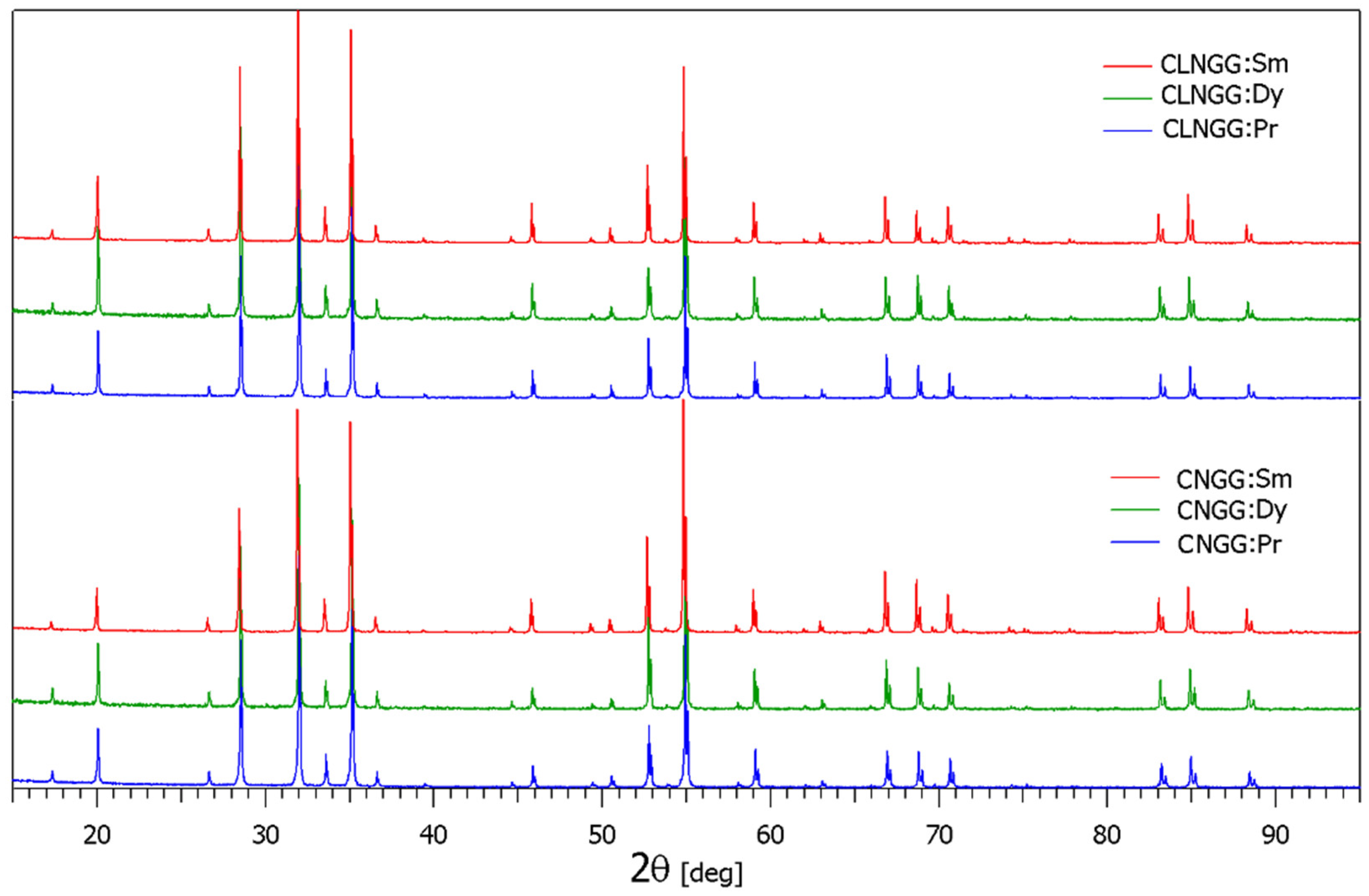
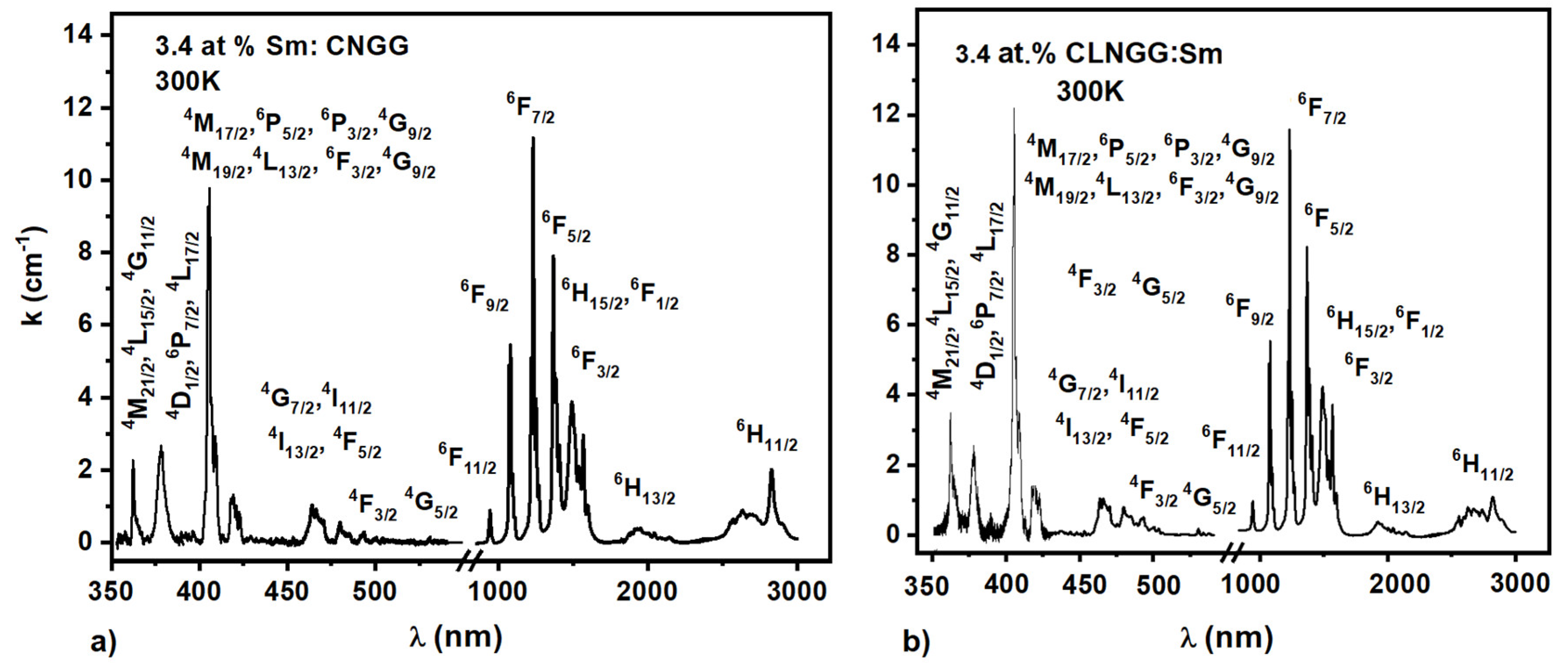
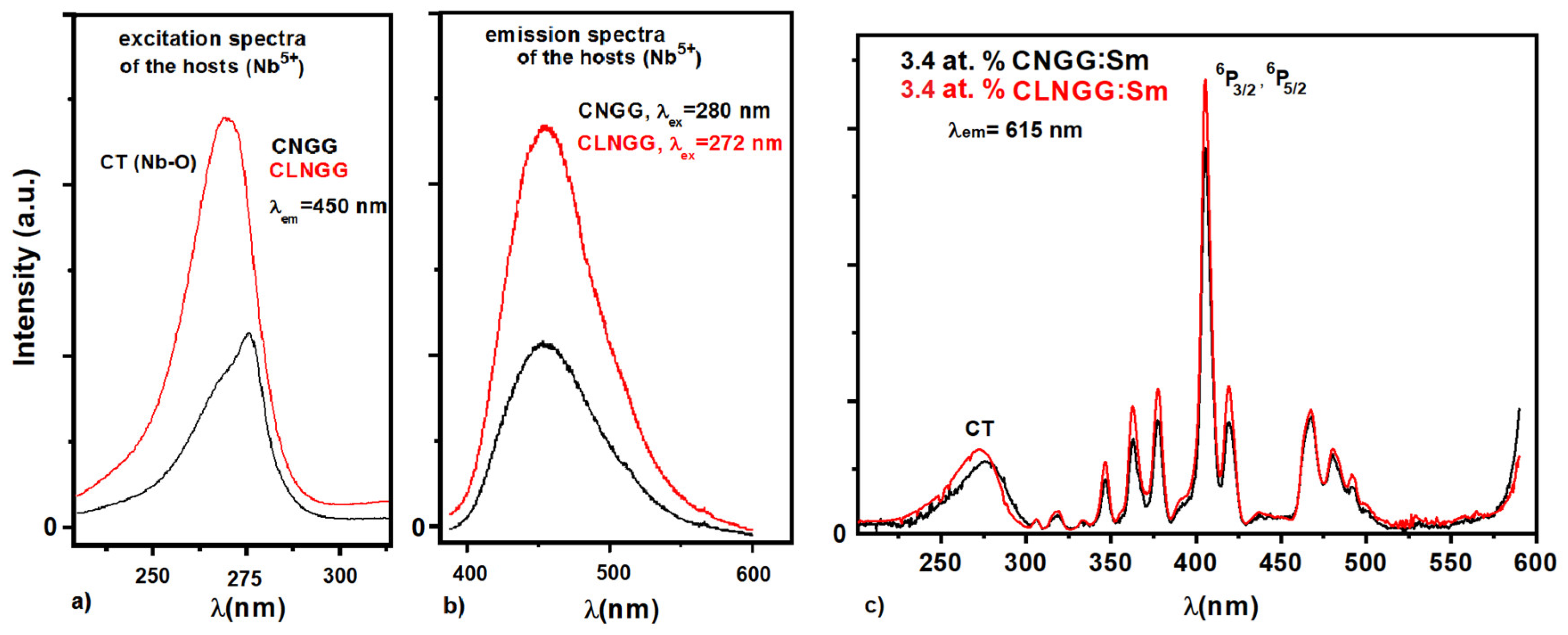
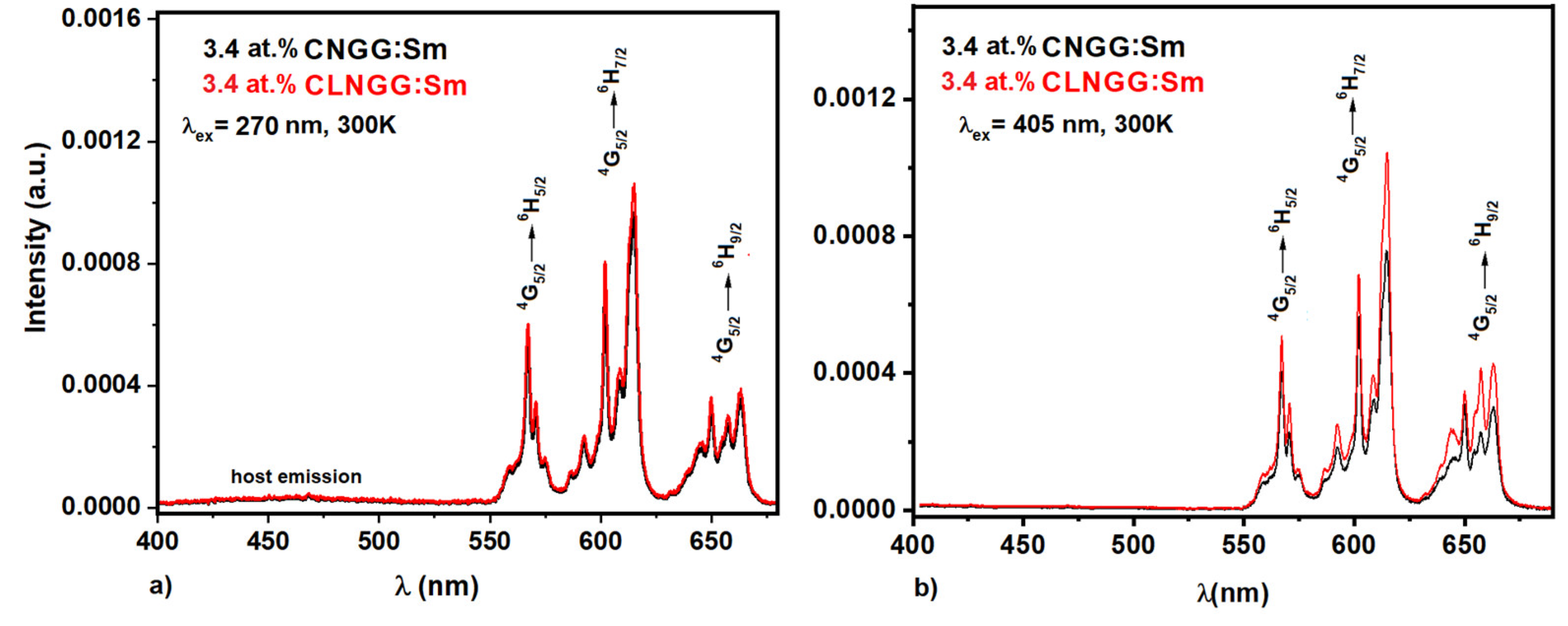
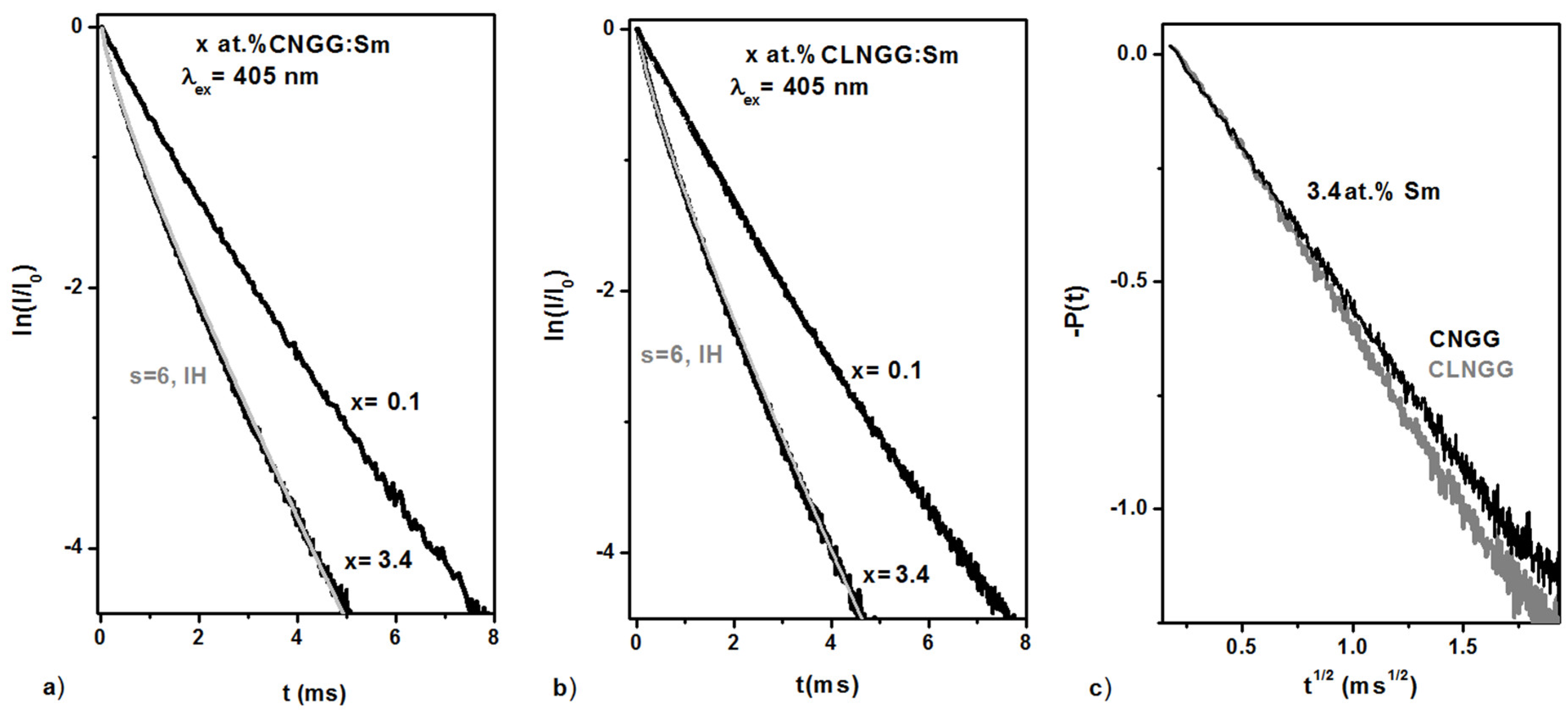
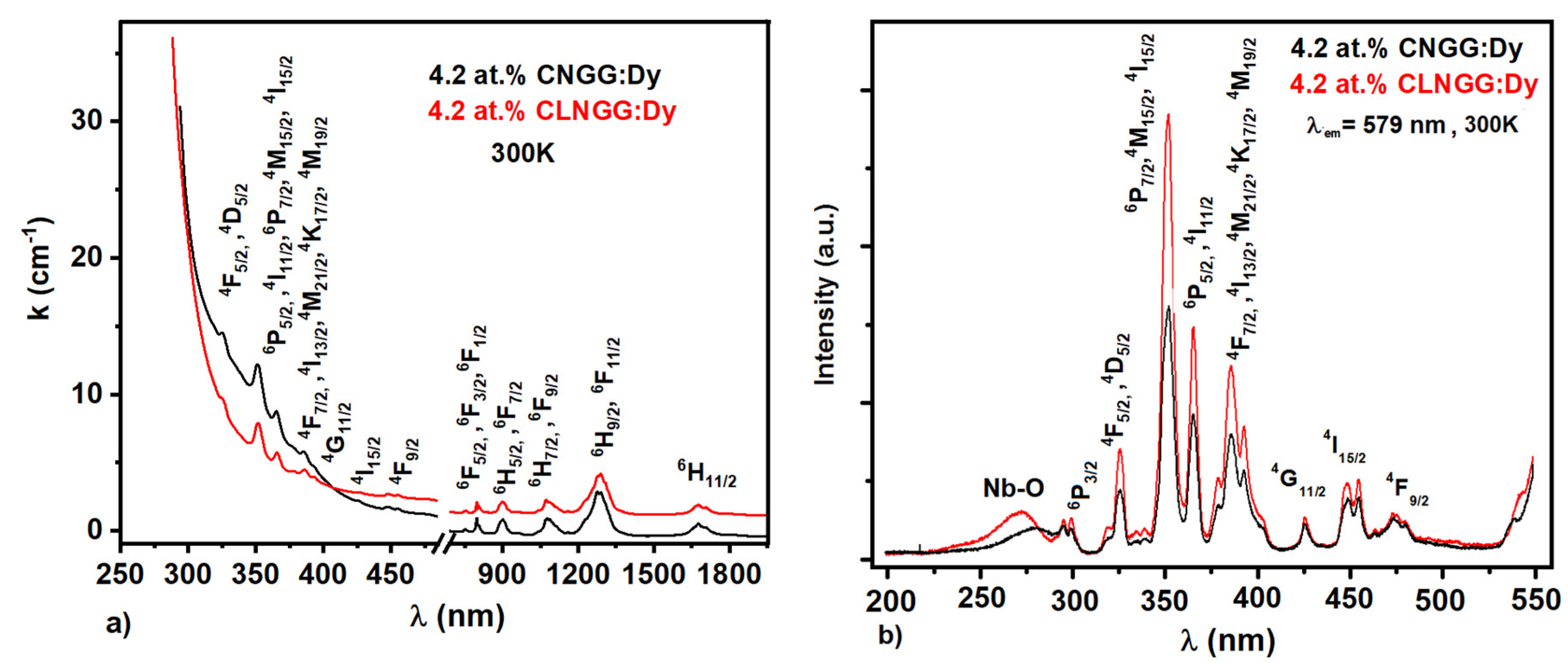

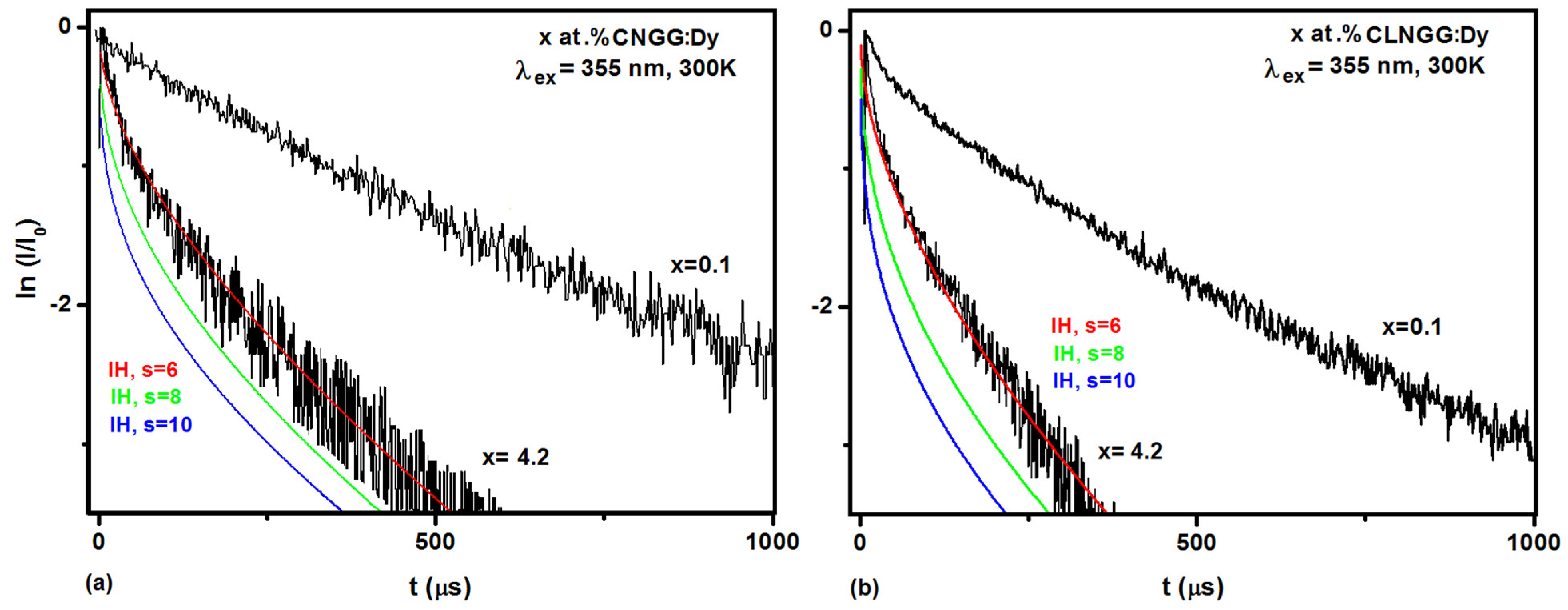
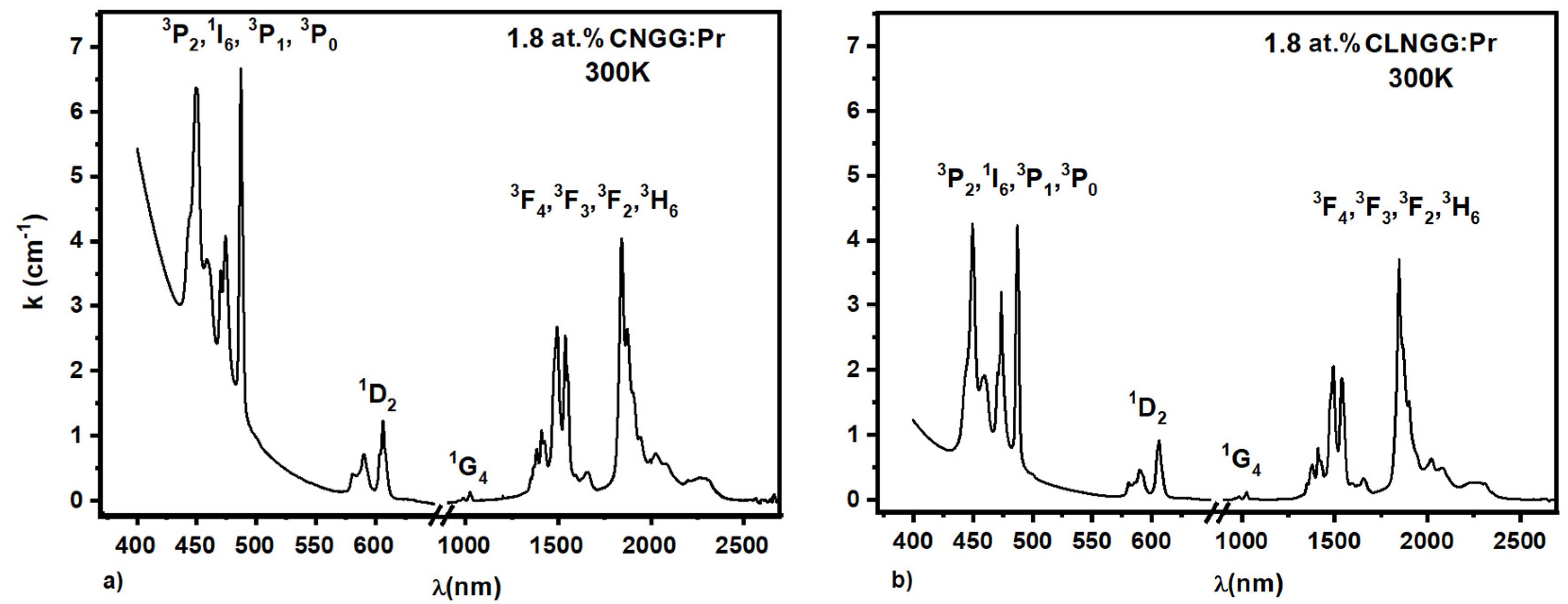
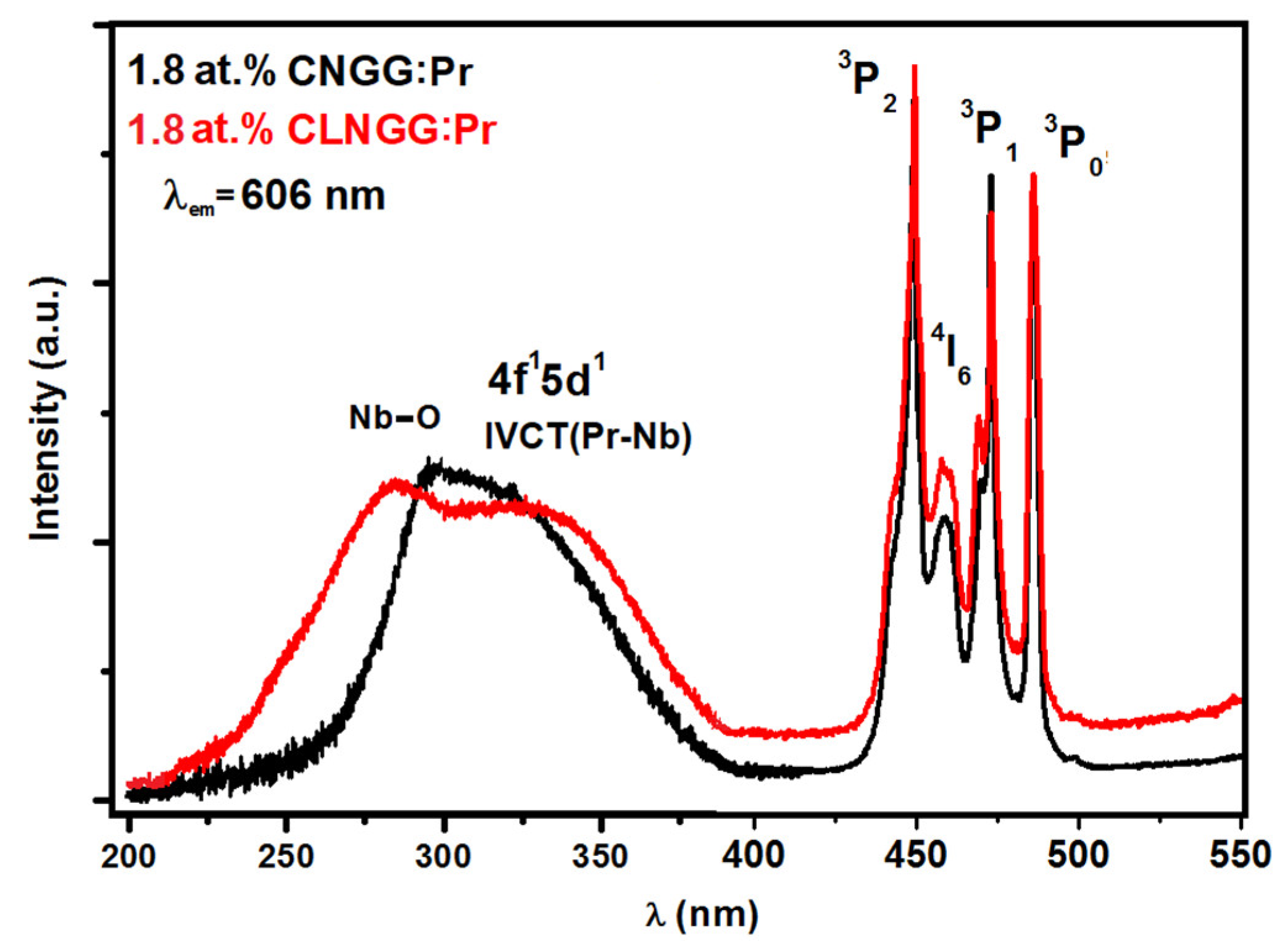
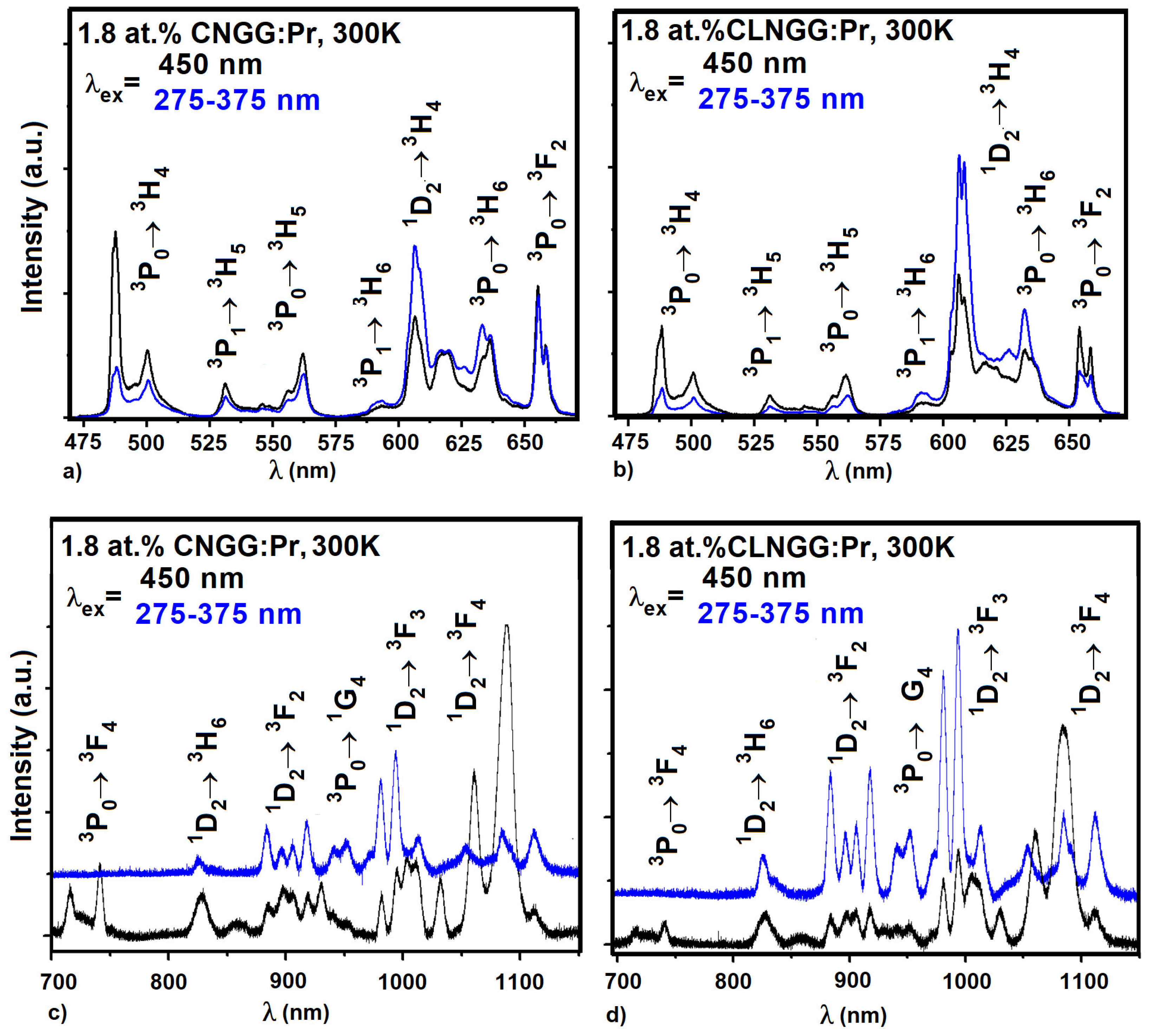
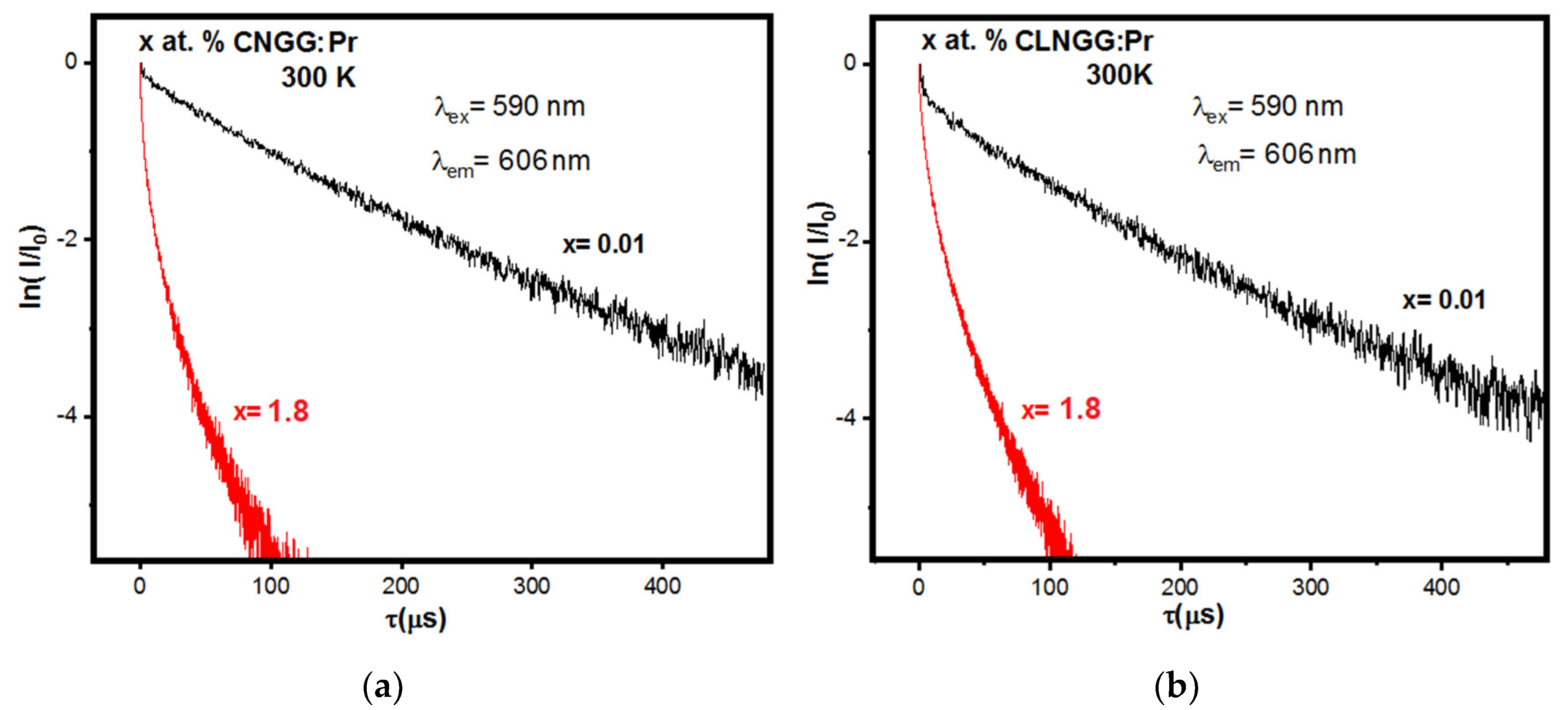
| Crystal | Elemental Composition | Lattice Parameters (Å) |
|---|---|---|
| CNGG | Ca3Nb1.6875Ga3.1875O12 | 12.508(2) [17] |
| CNGG:Sm | (Ca0.966Sm0.034)3Nb1.688Ga3.187O12 | 12.502(5) |
| CNGG:Dy | (Ca0.958Dy0.042)3Nb1.686Ga3.189O12 | 12.493(1) |
| CNGG:Pr | (Ca0.982Pr0.018)3Nb1.684Ga3.191O12 | 12.525(1) |
| CLNGG | Ca3Li0.275Nb1.775Ga2.95O12 | 12.511(0) [17] |
| CLNGG:Sm | (Ca0.966Sm0.034)3Li0.279Nb1.777Ga2.944O12 | 12.506(4) |
| CLNGG:Dy | (Ca0.958Dy0.042)3Li0.277Nb1.776Ga2.947O12 | 12.501(0) |
| CLNGG:Pr | (Ca0.982Pr0.018)3Li0.276Nb1.775Ga2.949O12 | 12.517(1) |
| Crystal | Ω2 × 10−20 (cm2) | Ω4 × 10−20 (cm2) | Ω6 × 10−20 (cm2) |
|---|---|---|---|
| YAG:Sm [57] | 1.2 | 2.08 | 1.72 |
| CNGG:Sm | 3.06 | 3.89 | 2.6 |
| CLNGG:Sm | 4.19 | 4.4 | 2.49 |
| CaNb2O6:Sm [58] | 6.33 | 6.49 | 3.72 |
| LiNbO3:Sm [59] | 2.11 | 4.5 | 1.45 |
| LiNbO3:Mg:Sm [60] | 1.86 | 2.82 | 1.19 |
| LiNbO3:Zn:Sm [60] | 1.68 | 2.72 | 1.12 |
| Transition from 4G5/2 → | CNGG:Sm | CLNGG:Sm | ||||||||
|---|---|---|---|---|---|---|---|---|---|---|
| (nm) | (S−1) | (S−1) | βJJ’ (%) | τr(ms) | (nm) | (S−1) | (S−1) | βJJ’(%) | τr(ms) | |
| 6F11/2 | 1359 | 0.58 | 0.0009 | 1361 | 0.56 | 0.0007 | ||||
| 6F9/2 | 1146 | 3.21 | 0.005 | 1147 | 4.22 | 0.006 | ||||
| 6F7/2 | 1016 | 5.24 | 2.15 | 0.01 | 1016 | 5.92 | 2.14 | 0.011 | ||
| 6F5/2 | 936 | 23.6 | 6.8 | 0.04 | 936 | 25.84 | 6.84 | 0.053 | ||
| 6H15/2 | 880 | 0.86 | 0.02 | 879 | 0.8 | 0.02 | ||||
| 6F3/2 | 878 | 4.45 | 10.76 | 0.0004 | 878 | 5.9 | 10.7 | 0.001 | ||
| 6F1/2 | 869 | 4.05 | 0.006 | 869 | 5.4 | 0.007 | ||||
| 6H13/2 | 782 | 10.7 | 0.016 | 771 | 11 | 0.015 | ||||
| 6H11/2 | 708 | 52.2 | 0.08 | 708 | 56.2 | 0.08 | ||||
| 6H9/2 | 647 | 205 | 0.32 | 647 | 215.8 | 0.32 | ||||
| 6H7/2 | 600 | 233 | 25.2 | 0.41 | 600 | 240.8 | 25 | 0.37 | ||
| 6H5/2 | 566 | 14.3 | 30.2 | 0.07 | 1.58 | 566 | 17.5 | 29.97 | 0.06 | 1.5 |
| Crystals | Transition from 4G5/2 → | σem ×10−21 cm2 | |
|---|---|---|---|
| CNGG:Sm | 6H5/2 | 567 | 0.187 |
| 6H7/2 | 615 | 0.87 | |
| 6H9/2 | 662 | 0.63 | |
| CLNGG:Sm | 6H5/2 | 567 | 0.184 |
| 6H7/2 | 615 | 1 | |
| 6H9/2 | 663 | 0.79 | |
| CaNb2O6:Sm [58] | 6H7/2 | 610 | 2.42 |
| LiNbO3:Sm [59] | 6H7/2 | 617 | 0.82 |
| GdVO4:Sm [64] | 6H7/2 | 604 | 0.9 |
| Multiplets | CNGG:Sm [21] | Bc (cm−1) | CLNGG:Sm [21] | Bc (cm−1) | YAG:Sm [57] | Bc (cm−1) |
|---|---|---|---|---|---|---|
| 4G5/2 | 17630 | 17852 | 17633 | 17853 | 17601 | 17784 |
| 17908 | 17909 | 17867 | ||||
| 18846 | 18850 | 17883 | ||||
| 6H9/2 | 2543 | 2404 | 2555 | 2419 | 2618 | 2461 |
| 2491 | 2525 | 2568 | ||||
| 2408 | 2417 | 2466 | ||||
| 2339 | 2352 | 2401 | ||||
| 2238 | 2244 | 2254 | ||||
| 6H7/2 | 1362 | 1214 | 1368 | 1219 | 1419 | 1261 |
| 1289 | 1299 | 1371 | ||||
| 1190 | 1191 | 1242 | ||||
| 1016 | 1019 | 1012 | ||||
| 6H5/2 | 228 | 109 | 233 | 113 | 251 | 130 |
| 98 | 106 | 141 | ||||
| 0 | 0 | 0 |
| IH Fitting | CNGG:Sm [21] | CLNGG:Sm [21] | YAP:Sm [65] | KZnLa(PO)4:Sm [66] | LGSO:Sm [67] |
|---|---|---|---|---|---|
| S | 6 | 6 | 6 | 6 | 6 |
| R0 (Å) | 6.59 | 6.86 | 7.22 | 10.96 | 7.9 |
| CDA (m6s−1) | 5.31 × 10−53 | 7.01 × 10−53 | 5.9 × 10−53 | 4.04 × 10−52 | 3.64 × 10−52 |
| WDA (s−1) | 525 | 691 | 416.5 | 233.08 | 1497.4 |
| WET (s−1) | 325 | 358 | 510 | 865 | 450 |
| τr (ms) | 1.58 | 1.5 | 2.4 | 4.3 | 1.89 |
| τ0 (ms)(0.1 at.%) | 1.483 | 1.44 | |||
| τav (ms) | 1 | 0.95 | 2.14 | 0.911 | 1.74 |
| ɳ (%) | 67 | 66 | 89 | 21 | 92 |
| CNGG:Dy [23] | CLNGG:Dy [23] | ||||||||||
|---|---|---|---|---|---|---|---|---|---|---|---|
| Transition from | Level | (nm) | n | (S−1) | (S−1) | βJJ’(%) | (nm) | n | (S−1) | (S−1) | βJJ’(%) |
| 4F9/2 | 6F1/2 | 1335 | 1.9039 | 0.14 | 0 | 1315 | 1.8997 | 0.15 | 0 | ||
| 6F3/2 | 1280.5 | 1.9054 | 0.1064 | 0 | 1280 | 1.9007 | 0.1054 | 0 | |||
| 6F5/2 | 1152.8 | 1.9101 | 11.2 | 0.0061 | 1160 | 1.9050 | 10.78 | 0.006 | |||
| 6F7/2 | 999.8 | 1.9183 | 6.8 | 9.84 | 0.009 | 999.2 | 1.9136 | 6.75 | 9.78 | 0.0092 | |
| 6H5/2 | 930.9 | 1.9235 | 5.3 | 0.0029 | 931.7 | 1.9187 | 5.27 | 0.0029 | |||
| 6F9/2 | 849.4 | 1.9315 | 12.4 | 9.66 | 0.012 | 849.6 | 1.9267 | 12.33 | 9.58 | 0.012 | |
| 6H7/2 | 829.6 | 1.9338 | 12.6 | 5.99 | 0.01 | 829.1 | 1.9337 | 12.64 | 6.008 | 0.0104 | |
| 6F11/2 | 765.1 | 1.9427 | 32.3 | 90.8 | 0.06 | 764.6 | 1.9381 | 32.15 | 89.14 | 0.0678 | |
| 6H9/2 | 747.2 | 1.9457 | 26.4 | 5.52 | 0.01 | 747.2 | 1.9410 | 26.18 | 5.49 | 0.0177 | |
| 6H11/2 | 661.5 | 1.9637 | 107.8 | 21.8 | 0.07 | 660.9 | 1.9591 | 107.2 | 21.73 | 0.072 | |
| 6H13/2 | 574.9 | 1.9921 | 1131.8 | 0.628 | 574.8 | 1.9874 | 1122.7 | 0.627 | |||
| 6H15/2 | 480.8 | 2.0468 | 311.2 | 0.17 | 480.8 | 2.0410 | 308.57 | 0.172 | |||
| AT(4F9/2) = 1801.6 s−1, τr = 0.55 ms | AT(4F9/2) = 1786.5 s−1, τr = 0.559 ms | ||||||||||
| Ωt | Ω2= 5.04 × 10−20 cm2 Ω4= 1.81 × 10−20 cm2 Ω6 = 1.53 × 10−20 cm2 | Ω2= 5.29 × 10−20 cm2 Ω4= 1.49 × 10−20 cm2 Ω6 = 1.37 × 10−20 cm2 | |||||||||
| χ | 1.18 | 1.08 | |||||||||
| Crystals | 4F9/2 →6H13/2 σem (×10−20 cm2) | Y/B | ßcalc(%) | τrad(ms) | τexp(ms) |
|---|---|---|---|---|---|
| CNGG:Dy [23] | 0.337 | 2.95 | 62.8 | 0.55 | 0.438 |
| CLNGG:Dy [23] | 0.338 | 3 | 62.7 | 0.559 | 0.332 |
| YAG:Dy [69] | 0.3 | 1.3 | 50.96 | 0.9 | 0.669 |
| Gd2SiO5:Dy [70] | 0.68 | 1.66 | 54.35 | 0.542 | 0.497 |
| GdVO4:Dy [71] | 0.9 | 4 | 68.3 | 0.264 | 0.084 |
| GGG:Dy [72] | 0.26 | 1.32 | 49 | 1.1 | 0.79 |
| Multiple’s | CNGG:Dy [23] | Bc (cm−1) | CLNGG:Dy [23] | Bc (cm−1) | YAG:Dy [73] | Bc (cm−1) |
|---|---|---|---|---|---|---|
| 4F9/2 | 21,547 | 21,169 | 21,554 | 21,172 | 21,551 | 21,096 |
| 21,210 | 21,210 | 21,119 | ||||
| 21,136 | 21,140 | 21,056 | ||||
| 21,001 | 21,001 | 20,896 | ||||
| 20,950 | 20,954 | 20,859 | ||||
| 6H13/2 | 3960 | 3776 | 3960 | 3777 | 3948 | 3731 |
| 3936 | 3938 | 3821 | ||||
| 3845 | 3847 | 3776 | ||||
| 3774 | 3776 | 3720 | ||||
| 3697 | 3695 | 3699 | ||||
| 3643 | 3647 | 3590 | ||||
| 3575 | 3577 | 3564 |
| IH Fitting | CNGG:Dy [23] | CLNGG:Dy [23] | Bi4Si3O12:Dy [57] | LSO:Dy [58] | Lu2SiO5:Dy [59] |
|---|---|---|---|---|---|
| s | 6 | 6 | 6 | 6 | 6 |
| R0 (Å) | 11.8 | 12.413 | 9.15 | 8.90 | 8.9 |
| CDA (m6s−1) | 0.512 × 10−52 | 0.908 × 10−52 | 0.65 × 10−51 | 7.8 × 10−52 | 5.3 × 10−52 |
| WDA (s−1) | 1843 | 2481 | 1107.6 | 1569.4 | 1066 |
| WET (s−1) | 681 | 681 | 856 | 338 | 390 |
| τr (ms) | 0.550 | 0.559 | 1.684 | 0.635 | 0.635 |
| τ0 (ms)(0.1 at.%) | 0.543 | 0.405 | |||
| τav (ms) | 0.229 | 0.143 | 0.690 | 0.202 | 0.509 |
| ɳ (%) | 73 | 72 | 41 | 32 | 80 |
| Multiplets | CNGG:Pr [24] | CLNGG:Pr [24] | |||||||
|---|---|---|---|---|---|---|---|---|---|
| ν (cm−1) | AED | AMD | β | ν (cm−1) | AED | AMD | β | ||
| 3P0 | 1D2 | 3721 | 9.31 | 0.0002 | 3716 | 11.63 | 0.0002 | ||
| 1G4 | 10,680 | 909.7 | 0.02 | 10,572 | 1086 | 0.02 | |||
| 3F4 | 13,475 | 3503 | 0.07 | 13,406 | 4457 | 0.08 | |||
| 3F3 | 13,970 | 0 | 0 | 13,962 | 0 | 0 | |||
| 3F2 | 15,229 | 14,644 | 0.32 | 15,225 | 18,298 | 0.33 | |||
| 3H6 | 16,046 | 1495 | 0.032 | 16,142 | 1320 | 0.02 | |||
| 3H5 | 17,999 | 0 | 0 | 18,024 | 0 | 0 | |||
| 3H4 | 20,298 | 23,725 | 0.52 | 20,303 | 29,254 | 0.53 | |||
| Ʃ A = 44,286 s−1, τr = 22 μs | Ʃ A = 54,426.63 s−1, τr = 18.3 μs | ||||||||
| 1D2 | 1G4 | 6959 | 429 | 0.09 | 6856 | 501.6 | 0.09 | ||
| 3F4 | 9754 | 1998.4 | 0.45 | 9690 | 24,44.6 | 0.43 | |||
| 3F3 | 10,249 | 187.7 | 11.2 | 0.04 | 10,246 | 233 | 14 | 0.04 | |
| 3F2 | 11,508 | 574.6 | 5.4 | 0.12 | 11,509 | 709.3 | 6.67 | 0.13 | |
| 3H6 | 12,325 | 514 | 0.11 | 12,426 | 644 | 0.11 | |||
| 3H5 | 14,278 | 26 | 0.05 | 14,308 | 319 | 0.05 | |||
| 3H4 | 16,577 | 714 | 0.15 | 16,587 | 751 | 0.13 | |||
| Ʃ A= 4460 s−1, τr = 224 μs | Ʃ A= 5623.2 s−1, τr = 177.8 μs | ||||||||
| Ωt mod | Ω2 = 3.607 × 10−20 cm2 Ω4 = 3.580 × 10−20 cm2 Ω6 = 1.264 × 10−20 cm2 rms = 0.086 × 10−20 cm2 | Ω2 = 4.563 × 10−20 cm2 Ω4 = 4.451 × 10−20 cm2 Ω6 = 1.105 × 10−20 cm2 rms = 0.12 × 10−20 cm2 | |||||||
| Crystal | 3P0→3H4 σem (cm2) | 1D2→3H4 σem (cm2) | 3P0→3F2 σem (cm2) |
|---|---|---|---|
| CNGG:Pr | 5.72 × 10−20 | 0.48 × 10−20 | 1.9 × 10−19 |
| CLNGG:Pr | 7.48 × 10−20 | 0.51 × 10−20 | 2.96 × 10−19 |
| CaSGG:Pr [81] | 7.3 × 10−20 | - | 1.02 × 10−19 |
| SrLaGa3O7:Pr [82] | 3.43 × 10−20 | - | 0.44 × 10−19 |
| GGG:Pr [83] | - | - | 1.24 × 10−19 |
| Pr3+ Multiplets | CNGG:Pr [24] | Bc (cm−1) | CLNGG:Pr [24] | Bc(cm−1) | YAG:Pr [84] | Bc(cm−1) |
|---|---|---|---|---|---|---|
| 3P0 | 20,603 | 20,603 | 20,601 | 20,601 | 20,534 | 0 |
| 1D2 | 17,235 17,105 16,974 16,590 16,512 | 16,883 | 17,227 17,111 16,978 16,575 16,534 | 16,885 | 17,210 17,088 16,881 16,409 16,400 | 16,798 |
| 3F2 | 5464 5409 5368 5335 5303 | 5375 | 5479 5410 5352 5332 5311 | 5376 | 6994 6973 6943 6876 6857 | 6929 |
| 3H4 | - 623 554 517 - - 66 21 0 | - | - 625 555 513 - - 74 22 0 | - | - 742 576 533 - - 50 19 0 | - |
Disclaimer/Publisher’s Note: The statements, opinions and data contained in all publications are solely those of the individual author(s) and contributor(s) and not of MDPI and/or the editor(s). MDPI and/or the editor(s) disclaim responsibility for any injury to people or property resulting from any ideas, methods, instructions or products referred to in the content. |
© 2022 by the authors. Licensee MDPI, Basel, Switzerland. This article is an open access article distributed under the terms and conditions of the Creative Commons Attribution (CC BY) license (https://creativecommons.org/licenses/by/4.0/).
Share and Cite
Gheorghe, C.; Hau, S.; Gheorghe, L.; Voicu, F.; Greculeasa, M.; Broasca, A.; Stanciu, G. RE3+-Doped Ca3(Nb,Ga)5O12 and Ca3(Li,Nb,Ga)5O12 Crystals (RE = Sm, Dy, and Pr): A Review of Current Achievements. Materials 2023, 16, 269. https://doi.org/10.3390/ma16010269
Gheorghe C, Hau S, Gheorghe L, Voicu F, Greculeasa M, Broasca A, Stanciu G. RE3+-Doped Ca3(Nb,Ga)5O12 and Ca3(Li,Nb,Ga)5O12 Crystals (RE = Sm, Dy, and Pr): A Review of Current Achievements. Materials. 2023; 16(1):269. https://doi.org/10.3390/ma16010269
Chicago/Turabian StyleGheorghe, Cristina, Stefania Hau, Lucian Gheorghe, Flavius Voicu, Madalin Greculeasa, Alin Broasca, and George Stanciu. 2023. "RE3+-Doped Ca3(Nb,Ga)5O12 and Ca3(Li,Nb,Ga)5O12 Crystals (RE = Sm, Dy, and Pr): A Review of Current Achievements" Materials 16, no. 1: 269. https://doi.org/10.3390/ma16010269
APA StyleGheorghe, C., Hau, S., Gheorghe, L., Voicu, F., Greculeasa, M., Broasca, A., & Stanciu, G. (2023). RE3+-Doped Ca3(Nb,Ga)5O12 and Ca3(Li,Nb,Ga)5O12 Crystals (RE = Sm, Dy, and Pr): A Review of Current Achievements. Materials, 16(1), 269. https://doi.org/10.3390/ma16010269








